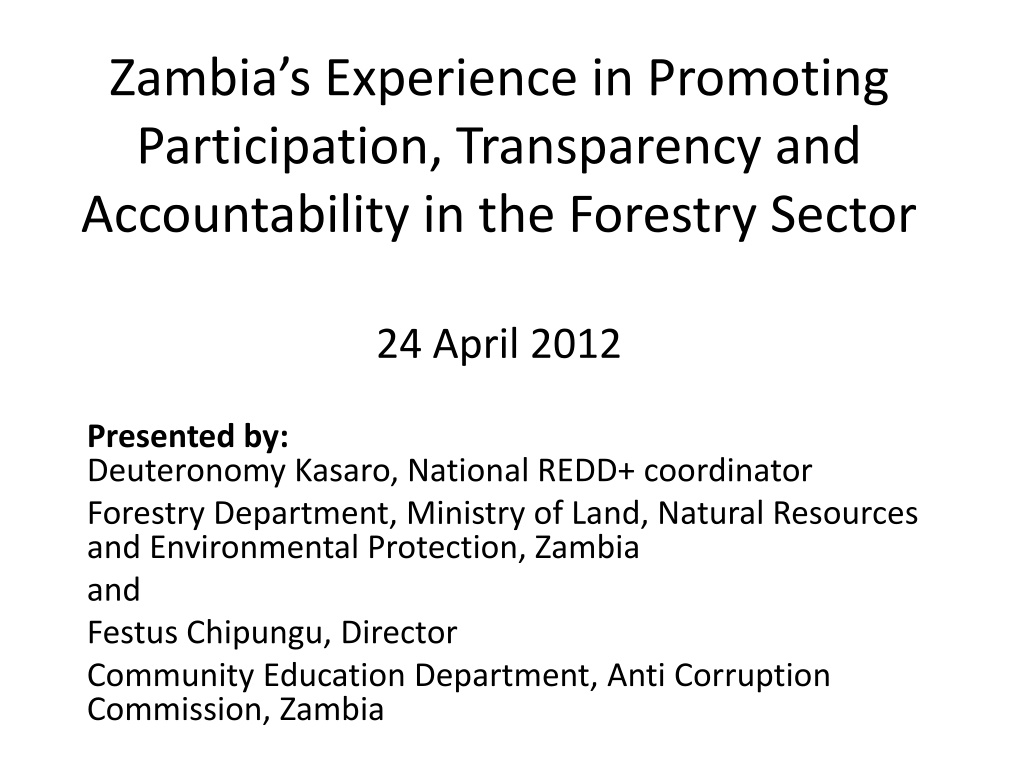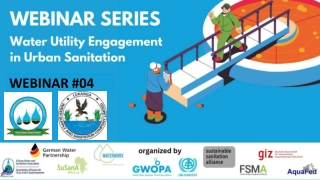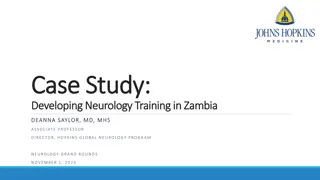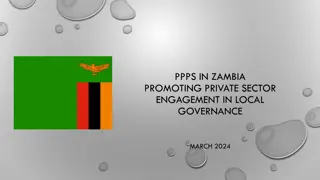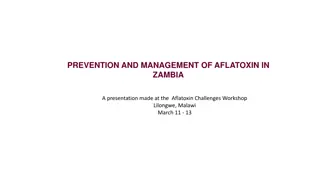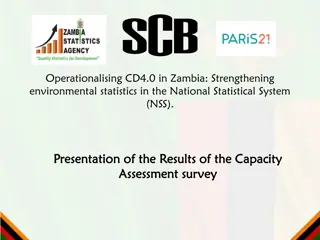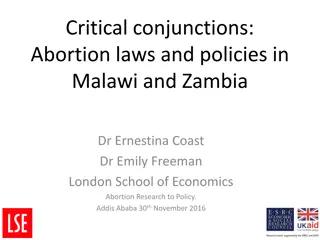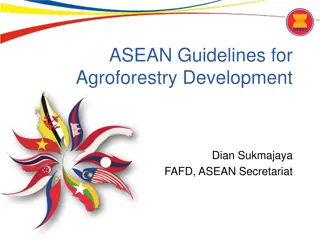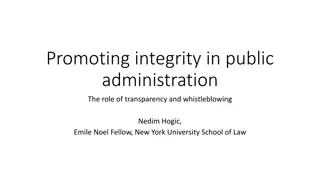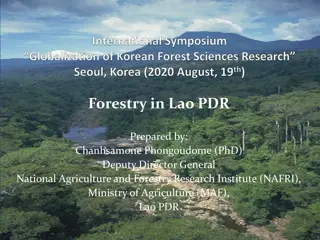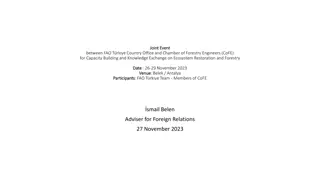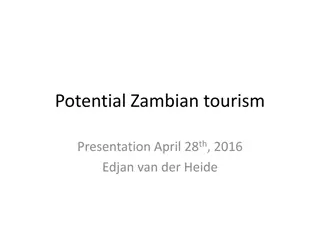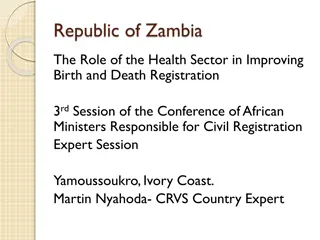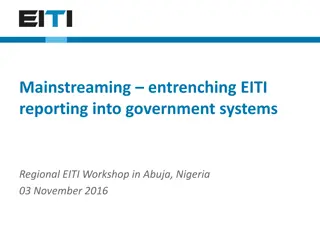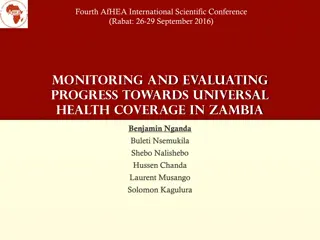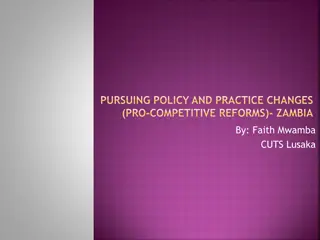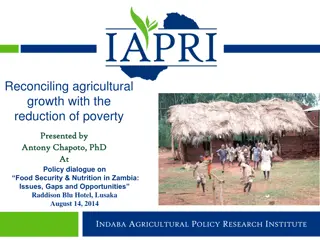Enhancing Transparency and Accountability in Zambia's Forestry Sector
Zambia's experience in promoting participation, transparency, and accountability in the forestry sector is highlighted through initiatives like REDD+ implementation. The country's vast forest resources, including various vegetation types and significant carbon storage, pose both challenges and opportunities for sustainable management. REDD+ specifications, safeguards, and actions required in the readiness phase are key components ensuring effective governance, stakeholder participation, and conservation efforts.
Uploaded on Sep 09, 2024 | 0 Views
Download Presentation

Please find below an Image/Link to download the presentation.
The content on the website is provided AS IS for your information and personal use only. It may not be sold, licensed, or shared on other websites without obtaining consent from the author. Download presentation by click this link. If you encounter any issues during the download, it is possible that the publisher has removed the file from their server.
E N D
Presentation Transcript
Zambias Experience in Promoting Participation, Transparency and Accountability in the Forestry Sector 24 April 2012 Presented by: Deuteronomy Kasaro, National REDD+ coordinator Forestry Department, Ministry of Land, Natural Resources and Environmental Protection, Zambia and Festus Chipungu, Director Community Education Department, Anti Corruption Commission, Zambia
Forest Resources in Zambia Zambia surface land area is 752,614Km2 Forests cover about 49.9 million ha (66% of land cover), The forest vegetation type is mainly (Semi-evergreen forests); Mopane, Kalahari Forests), Ripian, Swap, Parinari, Itigi, Lake basin Chipya (Evergreen forests), Termitary associated bushes (Shrub thickets), grasslands, wooded grasslands. Plantations cover about 61,000 ha ( 7,000 ha by the Forestry Department and 50,000 ha under ZAFFICO, the rest by communities, farmers, schools etc.) 2.9 billion m3of growing stock, 5.6 billion tonnes as national biomass(below and above), 434 million tonnes as dead wood biomass. TOTAL: 6 billion tonnes (ILUA 2008). About 2.8 billion tonnes of Carbon stored in forests Miombo Munga, (Deciduous Baikiaea, woodlands
What is REDD+? Not only a Policy Framework with the goal of creating an economic value for the carbon in standing forests; and But also an innovative system that motivates multi-sectoral actors to address the drivers of deforestation
REDD+ Specifications Safeguards Scope of REDD+ Principles Consistent Country-driven Transparent & Effective Governance Reduce Deforestation National circumstances Rights of local Communities Reduce Forest Degradation Consistent with National development goals Stakeholder Participation Conservation of Forests Consistent with adaptation needs Biodiversity conservation and management Sustainable Forest management Equitable etc. financing Enhancement of Carbon stocks Ensure minimum risk for Reversals Results-based Avoid Displacement
Actions required in the Readiness Phase (as per the Cancun Agreements under the UN Convention on Climate Change) Develop : A national strategy A national forest reference emission level and/or forest reference level (interim measure, sub national) A robust and transparent national forest monitoring system for the monitoring and reporting of the REDD + activities (interim measure, sub national) A system for providing information on how seven social and environmental safeguards will be addressed and respected
Importance of REDD+ in Zambia Deforestation in Zambia is currently estimated to be between 250,000ha to 300,000ha per year and REDD+ will help manage forest sustainably - Will help promote natural regeneration which has a high potential in Zambia Since REDD+ is an incentive based mechanism and focusing on respecting the rights of local communities, it is expected that rural livelihoods may be enhanced There is potential for investment in sectors that drive deforestation and hence economic and rural development. Enhancement of foreign exchange earnings It will contribute to the implementation of public, private and community partnerships
Policy and Legislation Governing Forests in Zambia Forest management in Zambia is supported by a national policy and legislation. The Forestry Department is mandated to administer forests on behalf of government The Forestry Policy of 1998 provides policy guidance on the management of forestry in Zambia and promote participatory forest management The Forests Act of 1973 and now a new Forests Bill 2012 provides for legal guidance to manage the forests in Zambia
POTENTIAL ILLEGAL ACTIVITES IN THE IMPLEMENTATION OF REDD+ Illegal logging (including removal of forest cover) Wild fires Tax evasion (under reporting of carbon stocks) Export and import of illegally sourced timber or timber products, including charcoal Presentation of misleading data by sponsors and communities Inappropriate assurance of offset credits Over stating awarded emissions Fraudulent verifications and validations
CORRUPTION LEVELS IN ZAMBIA The Anti-Corruption Commission of Zambia generates an average of 500 and prosecutes an average of 50 cases and secures about 20 convictions per year. The World Bank presents Zambia s score in controlling corruption at 30% Transparency Zambia pegs Zambia s Bribe Payers Index at 14% (An individual has 14% chances of encountering a bribery situation) The National Governance Baseline Survey of 2004 reported that 40% of the respondents indicated having been asked for a bribe Auditor General s annual report shows huge sums of money amounting to hundreds of billions of kwacha misappropriated, stolen, mismanaged or unaccounted for every year. The 2007 World Bank report estimated that 30% of the firms having paid a bribe to secure contract.
CORRUPTION VULNERABLE AREAS Bidding process for concessions for harvesting hardwood especially in Western, Southern and North Western Provinces of Zambia Acquisition of land rights through traditional systems Declaring timber volumes, cutting outside timber areas and tax evasion Exporting of unprocessed timber Exploiting of the forest for charcoal and exporting of Charcoal Issuing of permits and licenses.
CAUSES OF CORRUPTION IN THE FOREST SECTOR Dishonesty, greed, desire for personal wealth etc. Exclusion of the public from decision making process due to lack of information, resources, capacity and influence High monetary returns from corruption and the evading of statutory obligations High demand for cheap timber by the International Market. Appointment of officials to high level positions who make decisions in favor of the appointing authorities
ZAMBIAS EFFORTS IN COMBATING CORRUPTION Campaigns involving civil society organizations Educational programs targeting Traditional rulers Reengineering of cultural and traditional beliefs and practices which promote corruption. Corruption prevention interventions which include setting up of integrity committees, operating system reforms, participative monitoring of vulnerable operations Investigating and prosecuting perpetrators of crimes Signing MoU with AG s office or the sharing of information Integrating governance issues in the school syllabus.
NEW DEVELOPMENTS STRENGTHENING THE FIGHT AGAINST CORRUPTION Enactment of the Public Interest disclosure Act (whistle blower protection) Enactment of the Forfeiture of the proceeds of Crime Act Restoration of the Abuse of office and possession of unexplained property provisions in the law.
